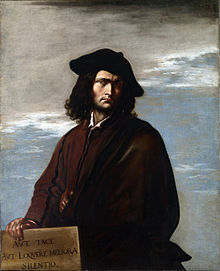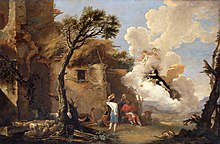Salvator Rosa
Salvator Rosa (born July 21 or 22, 1615 in Arenella ( Naples ), † March 15, 1673 in Rome ) was an Italian draftsman, painter, poet and actor. Rosa is one of the most extravagant artistic personalities of the 17th century.
His depictions of wild and mountainous landscapes are among his most popular and influential works, which are in extreme contrast to the pastoral landscapes of his contemporary Claude Lorraine . However, macabre pictorial themes as well as philosophical allegories and histories also belong to his subjects. As a poet, he is one of the most important Italian satirists of his time.
Life
After a very brief study of classical literature and music, Rosa came to the house of the painter Jusepe de Ribera in 1631/32 and became a pupil of Aniello Falcone . He also went through this training with Francesco Francanzano , who was his brother-in-law. In the spring of 1633 Rosa went on a short study trip through Apulia and Calabria to “explore nature and put it on paper”. He was attacked by bandits in Abruzzo and rumor has it that he even took part in their raids for some time.
He later returned to Naples, but found neither a job nor regular buyers of his works there. At the age of 19 he went to Rome in 1635 and initially lived there in very great poverty. Later he received the support of Cardinal Francesco Maria Brancaccio from Naples. In addition to doing a lot of different jobs to earn a living, Rosa continued to create picture after picture and over time she also found an interested audience.
In the next few years he was even able to afford a small studio in which people interested in art regularly met in good company. While Rosa gained friends and patrons through his amiable qualities, he made just as many enemies through his biting wit. In 1640, through the mediation of Cardinal Giancarlo de Medici (1611–1663) , he was appointed court painter to Florence , where he stayed until 1649.
In 1649 Rosa returned to Rome and died there on March 15, 1673 at the age of 57.
plant
Rosa's peculiar direction is particularly evident in his landscapes. With huge piles of rock, strong, jagged tree trunks, storm clouds or spotlights, it achieves a great overall effect, but sometimes remains overdramatized and unreal in detail. His scenes with bandits, soldiers, witches etc.
Rosa was, together with Aniello Falcone , the founder of battle painting as a realistic depiction of the war and the most important role model for Jacques Courtois . A large battle picture is in the Louvre , the conspiracy of Catiline can be seen in the Palazzo Pitti in Florence. These paintings follow Ribera's direction. Numerous pictures by Rosa are in England, others in the Louvre, in Dresden, Berlin, Vienna, Munich and Saint Petersburg. Engravings were made from many of his pictures. He himself etched 85 sheets, which were treated with great freedom and security, but which are rare in good impressions. There are also “satires” of him (Amsterdam 1664; new edition Florence 1770), one of which, Die Dichtkunst , by Fiorillo also contains a biography of the artist (Göttingen 1785).
Works (selection)
- Battle , oil on canvas 95 × 145 cm, Galleria degli Uffizi , Florence
- The Doubt of Saint Thomas , altarpiece from 1638, Museo Municipale di Viterbo
- Self-Portrait , 1640, National Gallery , London
- Portrait of Lucrezia , around 1650, Palazzo Barberini , Rome
- Reflecting Democritus , 1651, Statens Museum for Kunst , Copenhagen
- Humana fragilitas , 1656, Fitzwilliam Museum , Cambridge
- La Fortuna , 1659, J. Paul Getty Museum , Malibu
- Saul and the Witch by Endor , 1668, Musée du Louvre , Paris
- Jason and the Dragon , 1668, Musée des beaux-arts de Montréal
Literary adaptations
ETA Hoffmann created a literary monument to Salvator Rosa with his novella Signor Formica from the Serapion Brothers .
literature
- Achim Aurnhammer u. a. (Ed.): Salvator Rosa in Germany. Studies on its reception in art, literature and music . Rombach Verlag, Freiburg / B. 2008, ISBN 978-3-7930-9533-0 .
- Casimir von Chłędowski : Rome. The People of the Baroque , Chapter 14 (pp. 426–440): Salvator Rosa . Georg Müller, Munich 1921 ( digitized in the Internet Archive ).
- Herwig Gurasch u. a. (Ed.): Salvator Rosa. Genius of drawing . Verlag Wienand, Cologne 1999, ISBN 3-87909-667-8 . (Book accompanying the exhibition of the same name)
- Lady Morgan (di Sydney Owenson): Life and Times of Salvator Rosa. 2 volumes. Henry Colburn, London 1824.
- James S. Patty: Salvator Rosa in French literature. From the bizarre to the sublime . University Press, Lexington, Ky 2005, ISBN 0-8131-2330-5 .
- Walter Regel (Ed.): ... Highly praised, almost forgotten, seen again ... The Italian painter and poet Salvator Rosa. Re-evaluation studies . Königshausen & Neumann, Würzburg 2007, ISBN 978-3-8260-3667-5 . (Contents)
- Hans Werner Schmidt : The landscape painting Salvator Rosas . Halle (Saale) 1930.
Individual evidence
- ↑ a b c d e f g h i j k l m n Tomaso Montanari : Vélasquez et l'art du portrait baroque . In: Francis Morel (ed.): Les grands maîtres de l'art . No. 6 . Le Figaro, Paris 2008, ISBN 978-2-8105-0005-5 , pp. 307 (original edition at E-ducation.it (Scala Group), Firenze 2008).
- ↑ a b Klaus Bußmann , Heinz Schilling : 1648 - War and Peace in Europe. Catalog volume and two text volumes. Münster / Osnabrück 1998, ISBN 3-88789-127-9 , p. 145. (Documentation of the Council of Europe exhibition on the 350th anniversary of the Peace of Westphalia in Münster and Osnabrück)
Web links
- Literature by and about Salvator Rosa in the catalog of the German National Library
- Works by and about Salvator Rosa in the German Digital Library
- Salvator Rosa's biography on the Italian website popsoarte.it
- Landscape with Mercury and the lying lumberjack on the National Gallery of London website
| personal data | |
|---|---|
| SURNAME | Rosa, Salvator |
| BRIEF DESCRIPTION | Italian painter |
| DATE OF BIRTH | July 21, 1615 or July 22, 1615 |
| PLACE OF BIRTH | Arenella , ( Naples ) |
| DATE OF DEATH | March 15, 1673 |
| Place of death | Rome |



